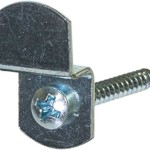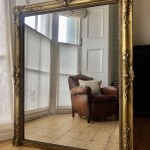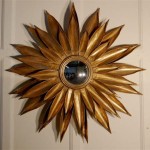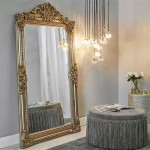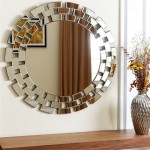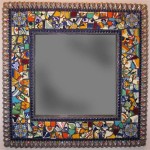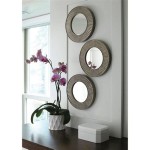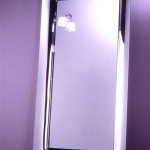How To Hang a Heavy Framed Mirror
Hanging a heavy framed mirror requires careful planning and execution to ensure both safety and aesthetic appeal. A poorly hung mirror poses a significant risk of falling and causing injury or damage. This guide outlines the necessary steps to securely and correctly mount a heavy framed mirror on a wall.
Assess the Mirror and Wall
Before beginning, gather information about both the mirror and the intended wall. Accurately determine the weight of the mirror. Bathroom scales or shipping information can provide this crucial data. Knowing the mirror's weight dictates the type of hardware needed to support it adequately. Next, determine the wall's construction. Drywall differs significantly from solid plaster or masonry in its ability to hold weight. Locating studs is essential for drywall installations, ensuring the heaviest mirrors are anchored to structural framing. A stud finder can easily locate these vertical supports within the wall.
For particularly heavy mirrors, especially on drywall, consider reinforcing the hanging point. A piece of plywood, cut slightly larger than the hanging hardware’s footprint, can be mounted to the studs prior to mirror installation. This distributes the weight over a wider area, providing additional support and preventing the hardware from pulling through the drywall.
Choose the Appropriate Hanging Hardware
Selecting the correct hanging hardware is paramount. D-rings and wire are commonly used for lighter mirrors but are generally insufficient for heavier ones. For significant weight, heavy-duty D-rings or strap hangers are recommended. These provide greater stability and distribute the weight more effectively. The chosen hardware should have a weight rating exceeding the mirror's actual weight; opting for a higher weight capacity provides an added safety margin.
The accompanying wall fasteners are equally important. Standard picture hooks are usually inadequate for heavy mirrors. Instead, opt for heavy-duty wall anchors, such as toggle bolts or molly bolts, especially for drywall installations. These anchors expand behind the wall surface, providing a much stronger grip than screws alone. For masonry or plaster walls, appropriately sized screws and wall plugs are recommended, ensuring a secure and stable fixing. Match the chosen hardware to the specific wall type for optimum performance.
Mark and Install the Hardware
Accurate measurements are crucial for level hanging. Measure the distance between the hanging points on the back of the mirror, whether D-rings or strap hangers. Mark these distances on the wall, ensuring they are level and account for the desired height of the mirror. Use a level to ensure the markings are perfectly horizontal. Any inaccuracies at this stage will result in a crooked mirror.
Once the markings are in place, install the wall anchors or screws according to the manufacturer's instructions. Ensure the anchors are firmly seated and flush with the wall. For heavier mirrors, pre-drilling pilot holes is highly recommended to prevent cracking the wall surface and ensure a clean installation. The size of the pilot hole should be slightly smaller than the diameter of the screw or anchor being used.
Hang the Mirror and Check Stability
Carefully lift the mirror and align the hanging hardware with the installed wall anchors. For particularly heavy mirrors, enlisting assistance is advisable to avoid strain and potential accidents. Once the mirror is hanging, gently tug on the bottom corners to check for stability. The mirror should remain firmly in place without any movement or shifting. If any instability is detected, re-evaluate the hardware and wall anchors to ensure they are appropriate for the mirror's weight and the wall's construction.
After confirming stability, conduct a final check of the mirror's levelness using a level. Minor adjustments can be made by slightly shifting the mirror on the anchors. If using wire, ensure it's taut and evenly distributed across the hooks. For added security, consider using small rubber bumpers on the back of the mirror's bottom corners. These bumpers provide a cushion against the wall, preventing scratches and adding another layer of stability.
Consider Specialized Hanging Systems
For exceptionally heavy or large mirrors, specialized hanging systems, such as French cleats or mirror mounting clips, offer additional support and security. These systems distribute the weight across a larger surface area and provide a more robust connection to the wall. Consult with a professional installer or hardware specialist to determine the most appropriate system for extremely heavy or oversized mirrors.
Careful consideration of the mirror's weight, wall type, and appropriate hardware is essential for safely and securely hanging heavy framed mirrors. Proper installation ensures the longevity and stability of the mirror, preventing accidents and preserving the integrity of the surrounding wall.
How To Hang A 100 Pound Mirror On Drywall Quora

How To Hang A Large Or Heavy Mirror

How To Hang A Heavy Mirror C R F T

How To Hang A Heavy Mirror

How To Hang A Large Wall Mirror Step By Tutorial

A Better Way To Hang Heavy Mirror Hanging Pictures

How To Hang A Heavy Mirror Or Picture True Value

How To Hang A Very Heavy Picture Or Mirror The Best

How To Hang A Heavy Mirror Diy Family Handyman

How To Hang A Heavy Mirror

